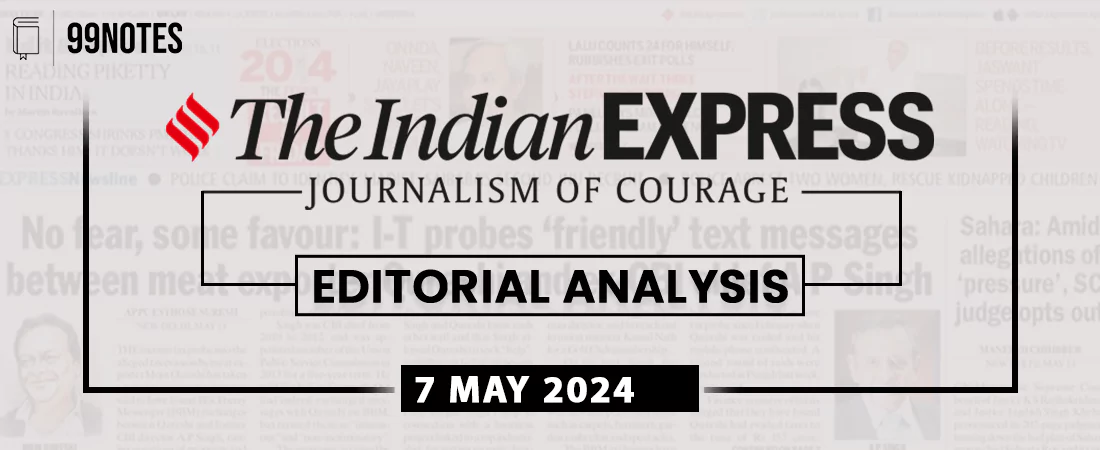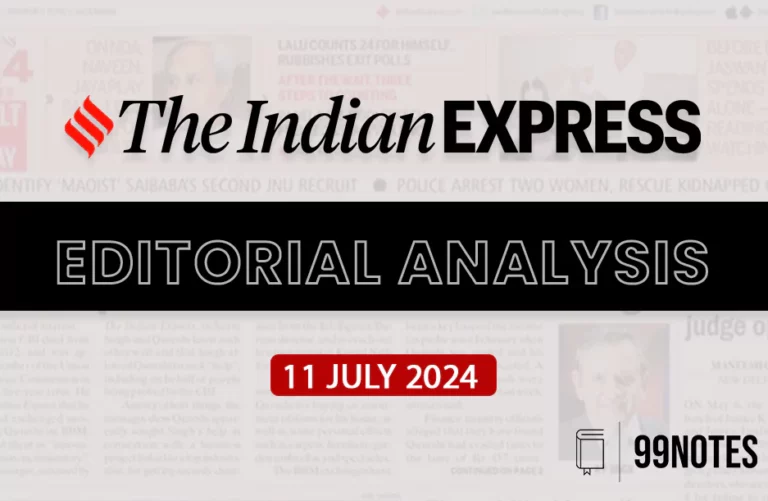7 May April 2024 : Indian Express Editorial Analysis
1. DON’T DEMONISE THE JAB
| Topic: GS3 – Science and Technology GS2 – Social Justice – Health |
| Context: |
|
Rarity of Side Effects:
- AstraZeneca’s admission highlights the occurrence of Thrombosis with Thrombocytopenia Syndrome (TTS), a rare side effect characterized by blood clots and low platelet levels.
- The rarity of this side effect is underscored by statistics from various sources, such as the Australian Department of Health and the World Health Organization, which estimate the risk to be between 1 in 100,000 to 1 in 250,000.
- Despite the rarity, the acknowledgment of this side effect is significant for public awareness and health monitoring.
About Thrombocytopenia Syndrome (TTS):
- It is a rare condition in which there is simultaneous occurrence of blood clots (thrombosis) and a low platelet count (thrombocytopenia).It is also known as ‘vaccine-induced immune thrombotic thrombocytopenia’ (VITT).
- Note: Thrombosis is the formation of a blood clot, which can reduce normal blood flow in an affected blood vessel.
Symptoms:
- Various symptoms are linked to TTS, such as shortness of breath, chest or limb pain, tiny red spots or bruising on the skin beyond the injection site, headaches, and numbness in certain body regions.
- TTS may result in restricted blood flow due to clot formation.
Risk versus Benefit:
- The analysis emphasizes the principle of risk versus benefit in medicine. It compares the risk of TTS associated with the AstraZeneca vaccine to the global risk of dying in a traffic accident, highlighting that the vaccine’s risk is substantially lower.
- Moreover, it draws parallels with the oral polio vaccine, which despite a rare risk of vaccine-associated paralysis, has been crucial in eradicating polio worldwide, showcasing the importance of considering broader public health benefits.
Challenges in Testing for Rare Risks:
- The analysis explores the challenges of detecting rare risks during vaccine development.
- Traditional clinical trials, with limited sample sizes and durations, may not detect risks as rare as 1 in 100,000.
- Conducting large-scale trials involving millions of volunteers over many years would be impractical and inefficient, especially during a pandemic.
- Thus, rare events like TTS often only become apparent after widespread vaccine rollout.
Importance of Observational Studies:
- Large-scale observational studies play a critical role in assessing vaccine safety in real-world conditions.
- The analysis cites studies published in April 2024, which identified potential rare side effects associated with Pfizer, Moderna, and AstraZeneca vaccines, such as Guillain-Barré syndrome and brain inflammation.
- These studies provide valuable insights into vaccine safety profiles and inform future research to enhance vaccine platforms’ safety.
Vaccines and Politics:
- The analysis warns against politicizing Covid-19 vaccines, citing a study linking excess mortality among Republican voters in the US to political rhetoric undermining trust in vaccines.
- It underscores the importance of depoliticizing vaccine discourse to maintain public trust and facilitate widespread vaccination efforts, crucial for curbing the pandemic’s impact.
Conclusion:
- The recent revelations regarding AstraZeneca’s vaccine side effects should be contextualized within the broader landscape of vaccine safety and public health.
- While rare side effects exist, the benefits of vaccination far outweigh the risks.
- It is imperative to prioritize public health, depoliticize vaccine discourse, and continue efforts to improve vaccine safety and accessibility for all.
| How are TTS and blood clots linked to the AstraZeneca vaccine? |
| 1. TTS was a rare syndrome reported in people who received a Covid-19 adenovirus vector-based vaccine. The incidence of TTS has been marginally higher among individuals under 60 years of age. 2. TTS can be seen in various body regions, including the brain, the abdomen, the lungs, limb veins and arteries. 3. The process that causes TTS is not fully understood, but it is believed to be similar to heparin-induced thrombocytopenia (HIT) which is also a rare reaction to a medicine called heparin that affects how platelets works. |
| PYQ: In the context of vaccines manufactured to prevent COVID-19 pandemic, consider the following statements: (2022) 1. The Serum Institute of India produced COVID-19 vaccine named Covishield using mRNA platform. 2. Sputnik V vaccine is manufactured using a vector based platform. 3. COVAXIN is an inactivated pathogen based vaccine. Which of the statements given above are correct? (a) 1 and 2 only (b) 2 and 3 only (c) 1 and 3 only (d) 1, 2 and 3 |
| Practice Question: What are the implications of AstraZeneca’s recent admission regarding the rare side effects of its Covid-19 vaccine, Covishield, for public health governance? Discuss the challenges in addressing rare adverse events in vaccination programs and suggest measures to maintain public trust in vaccine safety. (250 words/15 m) |
2. To auction or not
| Topic: GS2 – Governance – Government policies – Interventions for development in various sectors |
| Context: |
|
About the Spectrum Auctions:
- Devices such as cellphones and wireline telephones require signals to connect from one end to another. These signals are carried on airwaves (medium of radio waves), which must be sent at designated frequencies to avoid any kind of interference.
- Interference may prevent reception altogether, may cause only a temporary loss of a signal, or may affect the quality of the sound or picture produced by one’s equipment.
- The Union government owns all the publicly available assets within the geographical boundaries of the country, which also include airwaves.
- With the expansion in the number of cellphone, wireline telephone and internet users, the need to provide more space for the signals arise from time to time.
- To sell these assets to companies willing to set up the required infrastructure to transport these waves from one end to another, the central government through the Department of Telecom (Ministry of Communications) auctions these airwaves from time to time.
- These airwaves are called spectrum, which is subdivided into bands which have varying frequencies.
- All these airwaves are sold for a certain period of time, after which their validity lapses, which is generally set at 20 years.
Transition from Administrative Assignment to Auctions:
- Before 2010, spectrum allocation in India was primarily done administratively, leading to issues of opacity, favoritism, and scandals.
- The Supreme Court’s directive for spectrum auctions “for all time to come” was a response to these systemic shortcomings.
- The move towards transparency was crucial for ensuring fair allocation and preventing undue influence in the telecom sector.
Challenges with Auctions:
- The analysis suggests alternatives to auctions, such as providing spectrum to operators at reasonable upfront fees.
- This approach aims to balance revenue generation with promoting sectoral efficiency and competitiveness.
- Drawing parallels with infrastructure projects like toll roads, it emphasizes the role of spectrum as a vital input for digital infrastructure and economic development.
Policy Implications and Institutional Integrity:
- The recent move by the Department of Telecommunications (DoT) to seek modifications in spectrum allocation rules highlights the evolving policy landscape.
- The decision to allow administrative allocation in select cases underscores the need for flexibility and adaptability in regulatory frameworks.
- It also raises questions about the role of expert bodies like the Telecom Regulatory Authority of India (TRAI) in shaping telecom policy and regulatory decisions.
Conclusion:
- The analysis advocates for a nuanced approach to spectrum allocation that considers both transparency and sectoral growth objectives.
- While auctions have been instrumental in addressing past irregularities, their limitations in promoting long-term competitiveness warrant a reevaluation of policy approaches.
- Ultimately, the decision-making process should be guided by expert advice and informed by broader economic considerations.
| What spectrum do telecom companies require? |
|
| Practice Question: Discuss the evolution of spectrum allocation policies in India’s telecom sector, with a focus on the transition from administrative assignments to auctions. Analyze the benefits and challenges associated with spectrum auctions, and suggest alternative approaches to promote sectoral growth and competitiveness. (250 words/15 m) |





